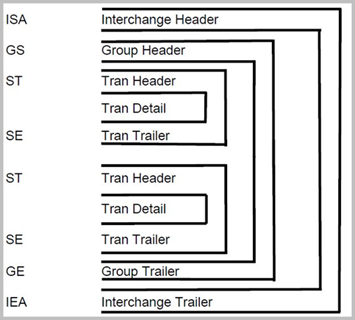About EDI
EDI (Electronic Data Interchange) is an asynchronous communication method used to exchange documents in a standard electronic format. Certain EDI transactions are used in the carrier industry, particularly by LTL and freight carriers, which employ EDI messaging during shipping. Messages are transmitted using protocols such as SFTP. Use the EDI Message Processor task to process new EDI messages in the system. See EDI Message Processor for detail.
The messages used by Transtream are:
- 204 - Motor Carrier Load and Tender. Used in the original shipping transaction.
- 990 - Response to Load Tender. Used to confirm that a shipment has been accepted, and to retrieve the carrier's PRO number (Housebill number) for the shipment. Note that 990 messages can take several hours to be received following the original 204 message.
- 214 - Transportation Carrier Shipment Status Message. Used after the shipment has been shipped to receive tracking statuses.
- 997 - Functional Acknowledgement. Used to send a response to incoming EDI messages.
EDI Carriers
EDI transactions are supported by the following carriers:
Use the EDI App to track and monitor the EDI transactions of the above carriers.
Additional Settings
You can configure additional settings per carrier, found in the All Settings page of the Administration App's Data tab:
- File Transfer Method. Controls the communication method used (such as FTP or SFTP) The setting is named for each carrier, E.g. YRC File Transfer Method.
- Using EDI Standards. Enables a fixed, built-in standard for EDI messages. Ensure the carrier can receive messages in the new format before activating the setting. The setting is named for each carrier, E.g. YRC Using EDI Standards. To operate with the standardized EDI messaging, an EDI Transaction Set Identifier number range must be configured; if not, EDI uploads will fail:
|
| Start | 1 |
| Stop | 999999999 |
| Increment | 1 |
| Type | EDI Transaction Set Identifier |
Number ranges are configured in the
Reference Data page of the
Administration App's
Data tab. For detail, see
Administration App - Data.
Message Parsing
If operating with carriers with the Using EDI Standards setting enabled, EDI messages are parsed to ensure transaction sets adhere to the correct structure and defined EDI rules. Messages are checked for specific data elements structured in the appropriate order. The following diagram outlines the standardized EDI message structure:

Incoming 204, 990, 997 and 214 messages are parsed; those that fail are not processed. 997 messages are returned to the carrier with a status of Rejected or Accepted, indicating the success of the transaction. The following errors cause an exception to be logged and terminates the process:
- ISA segment is missing, or not present as the first segment in the file.
- IEA segment is missing, or not present as the last segment in the file.
- IEA01 count is not 1.
- IEA02 does not match ISA13.
- GS segment is missing, or not present as the second segment in the file.
- GE segment is missing, or not present as the second to last segment in the file.
- GE01 is not a number.
- If any of the ISA, GS, GE and IEA segments do not meet EDI specifications.
A 997 response is not sent to the carrier for a message with any of the above errors; transactions with these errors can be viewed in the EDI App, and are flagged with an exclamation mark.
Article last edited 11 September 2024